In a world where the average person is bombarded with ads all day (and ignores most of them), advertisers really have no choice but to obsess over every pixel and call-to-action. Because let’s be honest — with display ads, one wrong shade of blue or an uninspired headline can tank your ROI faster than you can say "banner blindness."
In this article, we’ll dig into some of the most effective (and occasionally overhyped) examples of display ads. If you're hoping to stand out in this relentless ad parade, you might just find some inspiration here. Or at least a cautionary tale.

What is a display ad example?
It's time to describe some display ad examples. A display ad is usually any advertising unit that takes the form of an image, sound, video, text, or a combination of these forms.
This way, it can be a banner ad, social media ad, native, and even video in general. When someone says display ad, they usually refer to a static banner ad.
Display ad units can be targeted according to cookies, search queries, or other criteria. Before we see best display ads examples, let's connect the dots using a picture.
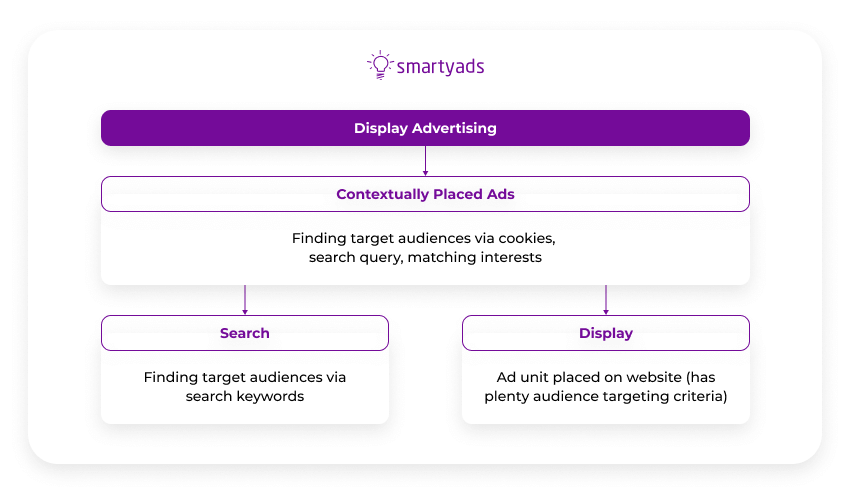
Contextual search ads
Contextual search ad is shown in search engines when the user enters a particular term in the search.
These are typically Google display ads that help advertisers find customers through the targeted keywords. Examples of display advertising of such you can find below.
Advertisers use targeted options of Google display network to discover the most popular keywords that users use while searching for products or services and then incorporate them into targeted campaigns. Read more about programmatic ad network vs. Google display network.
If the user's search terms match those of the Google display ad, the unit appears at the top of the search result page. You can see the display ads example of Google ads (search) in the picture below.
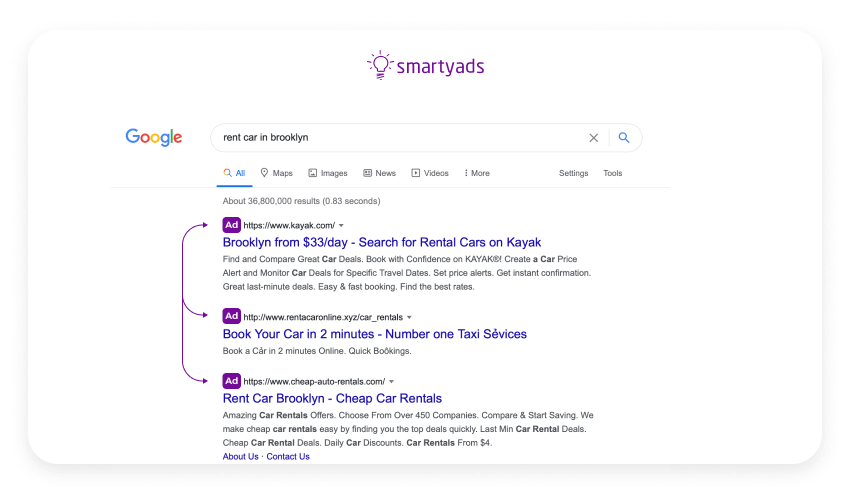
Apart from search, Google ads can also be served programmatically; they are targeted according to the myriads of targeting criteria, not only search terms. Such a Google display ad typically looks like a banner ad and is placed on the website dynamically.
Below you can see Google display ad examples that take into account user data and adjust to each user individually.
While Google display ad example on the left features the ad that corresponds to the website's thematics (tourism), the one on the right features automation solutions.
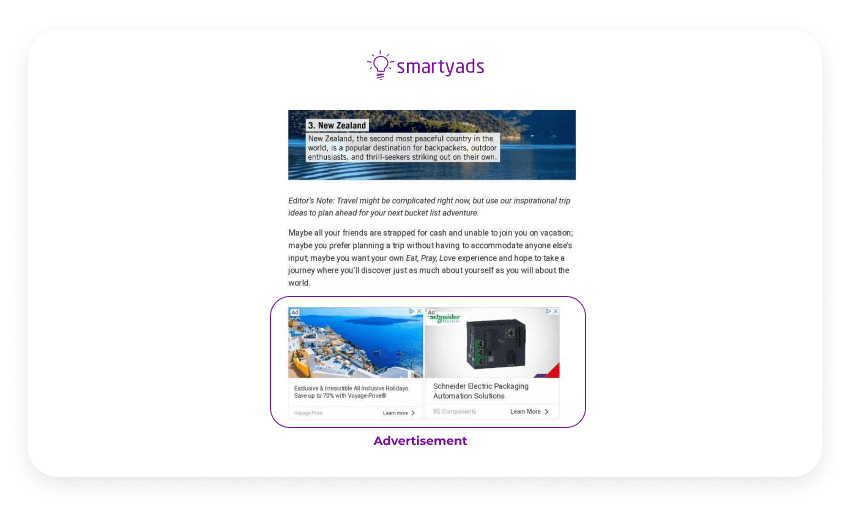
Contextual display ads are those ads that are placed on the website dynamically and, in the majority of cases, programmatically. This means every new user who enters the website or app sees a unique ad unit generated specifically for them. Again, technology is somehow similar to Google ads.
How do these display ads work? Through the application of smart media-buying algorithms that ensure that this or that ad unit may be interesting or useful to a particular user.
If you want to dig deeper into how these algorithms work, read about programmatic advertising and the programmatic ecosystem.
If an advertiser wants to find nearby customers, the best way to entice users will be by employing geotargeting mobile technologies. Below you can see how to make it work for display ad examples that we will review today.
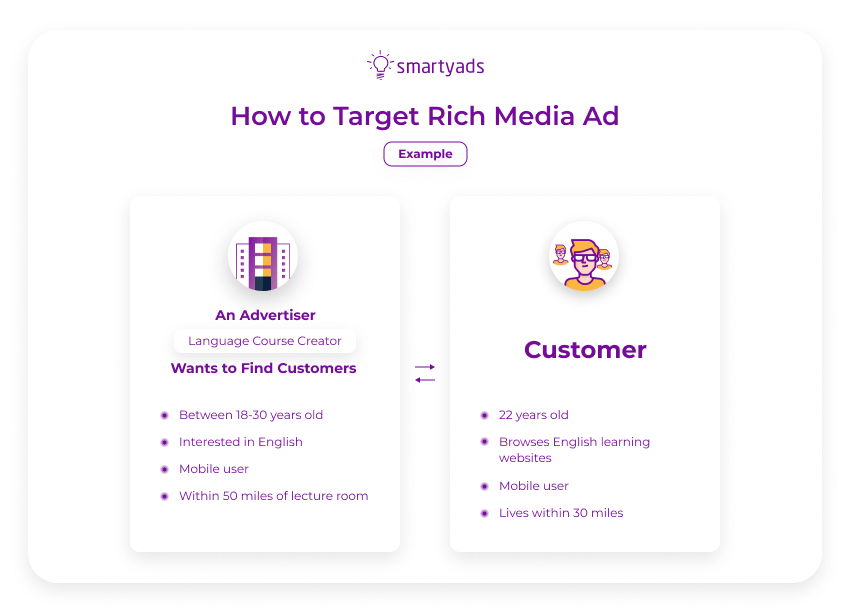
Types of Display Ads
When it comes to display ads, the variety can feel overwhelming — like a buffet where half the dishes look questionable, but you’re hoping to find something amazing. The truth is, each type of display ad has its strengths and its disasters.
Let’s dig into the most popular formats and see what they bring to the table — when done right.
Banner Ads: The Dinosaur That Still Roars (Sometimes)
Ah, the classic banner ad. It’s been around since the dawn of digital advertising, and like any true elder, it’s earned a mix of respect and eye-rolls. You’ve seen them plastered across every website, and so has your audience — which is exactly the problem. Banner blindness is real.
But! When done well, banners still work. The key? Design that doesn’t look like it was made in 2005 and messaging that offers something beyond “Buy now!” Sharp visuals, a clear call to action, and irresistible offers can still make these old-timers pull their weight.
When to use: For broad reach and brand awareness, especially when retargeting.
When to avoid: When your creative looks like it belongs in a pop-up from the early internet.
Responsive Display Ads: Let the Algorithm Take the Wheel
Google loves these, and for good reason — they take the heavy lifting off your plate. You provide a bunch of assets (headlines, images, logos), and Google’s machine-learning magic assembles them into different ad variations. Sometimes the results are surprisingly effective. Sometimes they look like a design intern’s first day on the job.
The upside? Efficiency and scale. You get more placements with less effort. The downside? You surrender some control. If you’re a perfectionist, watching your carefully crafted creative get rearranged by an algorithm can be painful.
When to use: When you need fast, scalable campaigns without custom creative for every placement.
When to avoid: When your brand identity relies on precise visuals and tone.
Native Ads: The Master of Disguise
Native ads are sneaky — in a good way. They blend so seamlessly with website content that users might not realize they’re looking at an ad until they’re halfway through clicking. Done right, they feel like a natural part of the browsing experience. Done wrong, they feel like clickbait.
The trick is balance: compelling, relevant content that aligns with the platform it’s on, without misleading the audience. When native ads respect the reader’s time and intelligence, they drive engagement like no other format.
When to use: For content-driven campaigns and when you want engagement over hard-sell tactics.
When to avoid: If your product or message can’t be wrapped into a relevant, valuable piece of content.
Video Ads: Because Nobody Reads Anymore
If a picture’s worth a thousand words, a video ad is worth… well, at least your media budget. Video grabs attention fast — which is why it’s so frustrating when brands waste those precious seconds on slow intros and irrelevant fluff.
Great video ads hook the viewer immediately, deliver value, and get to the point before the “Skip Ad” button becomes too tempting. Short, snappy, and optimized for silent viewing (because autoplay is still a thing), they can do wonders for brand storytelling and product showcases.
When to use: For emotional impact, product demos, and engaging storytelling.
When to avoid: If you can’t say something interesting in under 10 seconds.
Rich Media Ads: When You Want to Show Off
Think of rich media ads as the showboats of the display world — interactive, dynamic, and often pretty flashy. They can include video, animations, carousels, and even mini-games. Done right, they’re engaging and memorable. Done wrong, they’re just slow-loading distractions.
The key here is balance: interactivity should enhance the message, not drown it. A well-designed rich media ad keeps users engaged without frustrating them, offering an experience that’s worth the click.
When to use: For high-impact campaigns and when you want users to interact with your ad.
When to avoid: If load times or mobile performance are concerns.
10 Display Ad Examples for Inspiration
1. Banner Ad by Apple: Minimalism Done Right
.webp)
Apple’s banners are a masterclass in "less is more." Picture a clean background, a sleek product shot, and three words: "Privacy. That’s iPhone." No clutter, no screaming discounts — just quiet confidence. This approach reflects Apple's brand identity — refined, sophisticated, and focused on quality. By eliminating distractions, the ad draws immediate attention to the product and its core message.
Why it works: In a sea of over-designed, text-heavy ads, Apple’s simplicity stands out. It’s premium, unmistakable, and effective. The minimalism reflects the elegance of the brand and enhances recall.
2. Responsive Ad by Airbnb: Let the Algorithm Shine
.webp)
Airbnb’s responsive display ads combine stunning photos of unique homes with tailored headlines like "Stay, on the move" or "Stay somewhere extraordinary." Google’s algorithm assembles the best mix for each user — and when it hits right, it’s magic. This dynamic format ensures that users see personalized, appealing content that aligns with their interests and behaviors.
Why it works: Smart targeting + beautiful visuals = instant wanderlust and serious booking temptation. The algorithm-driven content maximizes engagement, ensuring the right message reaches the right audience.
3. Native Ad by The New York Times x Netflix: When an Ad Is Journalism
.webp)
Before the launch of Orange Is the New Black, NYT published a sponsored article on women’s prisons. It was so well-researched and engaging you didn’t even realize it was an ad until halfway through — and by then, you were hooked. The in-depth storytelling and journalistic quality blurred the line between content and advertisement.
Why it works: It’s not just an ad — it’s valuable, compelling content. And that’s what makes it unforgettable. By offering real insights and emotional depth, it captured attention and drove interest in the show.
4. Video Ad by Nike: So Win
After a 27-year hiatus from Super Bowl advertising, Nike made a triumphant return with their 'So Win' campaign during Super Bowl LIX. Narrated by Grammy-winning rapper Doechii and set to Led Zeppelin's 'Whole Lotta Love,' the ad features elite female athletes like Caitlin Clark, JuJu Watkins, and Jordan Chiles. It confronts the double standards and criticisms faced by women in sports, delivering a powerful message: 'Whatever you do, you can't win. So win.'
Why it works: By addressing societal biases head-on and showcasing top-tier talent, Nike reinforces its commitment to empowerment and equality, resonating deeply with audiences. The combination of cultural relevance, emotional storytelling, and iconic music made this ad unforgettable.
5. Interactive Ad by Burger King: 'Burn That Ad' – Flame-Grilled Fun
That Ad' campaign was a perfect blend of creativity and technology. Using augmented reality (AR), users could virtually 'burn' competitors' advertisements on their mobile screens, revealing a coupon for a free Whopper. This innovative approach not only entertained users but cleverly tied into the brand’s signature flame-grilled concept. The interactive nature of the ad turned a simple promotional campaign into an engaging digital experience, boosting app engagement and reinforcing the brand’s playful personality.
Why it works: Interactive elements combined with a tangible reward create a memorable experience that encourages participation and brand loyalty. The use of AR technology made the ad stand out while turning advertising into entertainment, strengthening customer connections and enhancing the brand’s identity.
6. Banner Ad by Spotify: Hyperlocal Humor FTW
.webp)
Spotify’s localized campaigns are a masterclass in humor and personalization. One standout banner humorously read: "Dear person who played 'All I Want for Christmas' in July — you’re our kind of people." By leveraging listener data in a playful and relatable way, Spotify created a campaign that felt tailored and intimate, sparking smiles and shares across social media. This ad showcased Spotify's ability to transform user habits into creative and endearing content.
Why it works: Humor + personalization = instant connection and brand love. The ad’s specificity makes users feel seen and appreciated, fostering a positive emotional response and enhancing engagement.
7. Responsive Ad by IKEA: Simplicity Scaled
.webp)
IKEA's recent campaign took a humorous and relatable approach, pairing images of guilty pets next to the damage they caused — a chewed-up couch or a scratched table — with the comforting tagline: 'Don't worry, you can afford it.' This creative concept emphasized IKEA’s affordability without being pushy, tapping into the everyday experiences of pet owners. The combination of visual storytelling and lighthearted messaging made the campaign memorable and highly shareable.
Why it works: By tapping into relatable pet-owner experiences and combining humor with practicality, IKEA effectively communicates value without overtly selling. It humanizes the brand and makes affordability a key selling point, creating an emotional connection with its audience.
8. Burger King's 'Whopper Detour' Campaign
.webp)
In 2018, Burger King launched the 'Whopper Detour' campaign, a geofencing strategy that invited customers to order a Whopper for just one cent—provided they were within 600 feet of a McDonald's. The mobile app would then redirect users to the nearest Burger King to claim their virtually 'stolen' Whopper.
Why it works: This campaign cleverly combined mobile technology with playful rivalry, driving app downloads and increasing foot traffic to Burger King locations. It turned location-based marketing into a competitive and highly effective stunt.
9. Dove's 'Courage Is Beautiful' Campaign
.webp)
In 2020, Dove launched the 'Courage Is Beautiful' campaign, featuring powerful images of healthcare workers marked by protective gear during the COVID-19 pandemic. The campaign honored their dedication and resilience, capturing a moment of global solidarity and compassion.
Why it works: By highlighting real heroes, Dove reinforced its brand values of authenticity and care, resonating deeply with audiences during challenging times. The emotional weight and sincerity made this campaign both memorable and impactful.
10. Apple's 'Shot on iPhone' Campaign
Apple's ongoing 'Shot on iPhone' campaign showcases stunning photographs and videos captured by everyday users, displayed on billboards and online platforms. This user-generated content strategy highlights the camera's capabilities and engages the community. It turns customers into brand ambassadors by celebrating their creativity.
Why it works: By featuring real users' work, Apple fosters a sense of community and authenticity, encouraging others to explore their creativity using the iPhone. The campaign’s global reach and high-quality visuals further enhance its effectiveness.

Display Ads Best Practices: How to Stand Out Without Annoying Everyone
Nail Your Message
Before you even think about colors or formats, get your message straight. Ask yourself: What do you want to say? What’s your offer? Why should anyone care? Keep it clear, keep it sharp. A vague or overly complicated message will get lost in the noise, and no one has time for that.
To craft a strong message:
- Define your goal: Are you driving sales, raising brand awareness, or collecting leads? Your message should reflect that.
- Highlight your unique value: What makes your offer different or better than competitors? Be specific.
- Keep it simple: Avoid jargon and fluff. Get to the point fast.
Match Visuals to Message (and Landing Page)
Let’s face it—if your ad’s visuals are just there to look pretty without backing up your message, you’re wasting everyone’s time (and probably some budget). A cohesive, well-thought-out experience builds trust and keeps users from feeling like they’ve been bait-and-switched. When someone clicks your ad, the landing page better feel like a natural next step—not like they’ve taken a wrong turn into a completely different universe.
Here’s how to align visuals and messaging:
- Use high-quality images: Blurry, pixelated visuals scream unprofessional.
- Match the vibe: If your ad is playful, your landing page shouldn’t feel like a tax form.
- Reflect your offer: If the ad promises a discount, make sure it’s front and center on the landing page.
Hook Them with the Right Incentive
Want clicks? Give people a reason to care. A strong hook sets you apart from the noise and makes your offer irresistible—because guess what? There are a thousand other ads out there vying for attention.
Consider these incentives:
- Limited-time discounts: Urgency drives action—people hate missing out.
- Free trials for B2B products: Let potential customers experience your service risk-free.
- Free delivery: Everyone loves saving on shipping. Make sure to call it out.
- Bonus gifts for early buyers: A little extra goes a long way in convincing people to act fast.
- Extra perks for social shares: Incentivize word-of-mouth by offering discounts or rewards for referrals.
Structure Your Ad (Yes, Structure Matters)
Every good display ad has a few essentials. Without a clear structure, your ad becomes noise. Think of it like a mini-billboard—people should get the point in seconds.
Key elements:
- Your logo: Make sure people know who’s talking. A well-placed, recognizable logo builds brand awareness.
- A clear value proposition: What’s in it for them? Make your offer obvious and compelling.
- A visual element: But don’t let it overshadow your message. It should support, not distract.
- A call-to-action (CTA): Tell people exactly what to do next—click, buy, sign up. Make it bold and action-oriented.
Choose the Right Ad Size
Yes, size matters—at least when it comes to ad visibility and effectiveness. The right dimensions make sure your message is seen clearly and not squished into oblivion.
Quick guide to ad sizes:
- Big ads (970x250): Great for immersive campaigns with strong visual impact.
- Medium ads (300x250): Versatile and widely supported across platforms.
- Small ads: Perfect for mobile where screen space is limited but attention is high.
Don’t Skimp on Visual Quality
If your ad looks like it was designed in 2003, people will treat it like it belongs there. Visual quality isn’t just about aesthetics—it’s about credibility.
Best practices for visual quality:
- Stick to brand colors: Maintain consistency across all marketing materials.
- Use contrast wisely: Ensure your text stands out against the background.
- Limit text: Let visuals do some of the heavy lifting.
Find the Sweet Spot on Frequency
Too few impressions and people forget you exist. Too many, and they start actively hating your brand. The sweet spot? Just enough to stay on their radar without being annoying.
Frequency tips:
- Test and adjust: Monitor engagement and tweak frequency based on results.
- Cap impressions: Avoid overwhelming users with the same ad.
- Rotate creatives: Keep things fresh by swapping out ad variations.
Targeting and Retargeting Done Right
Use programmatic tools to get your ad in front of the right people at the right time. For even more precise and privacy-safe targeting, especially when leveraging diverse data sets, consider exploring how a data clean room can enhance your strategy. And if you’re retargeting, mix up your channels—desktop for the first round, mobile for the follow-up.
Effective targeting strategies:
- Demographic targeting: Age, gender, income—know your audience.
- Behavioral targeting: Reach people based on their browsing habits.
- Geofencing: Target users when they’re near your physical location.
Prep and Optimize
Before you launch, get your house in order. A well-prepared campaign saves time and boosts performance.
Pre-launch checklist:
- Landing page: Ready and optimized with a clear offer and fast load times.
- Channels: Pick the right ones for your audience (social, display networks, etc.).
- Creative options: Always have backups to test and tweak for better performance.
Track Performance (But Actually Do It)
Watch impressions, clicks, and ad spend in real time. If something’s off, adjust fast. Performance data tells you what works—listen to it.
Metrics to track:
- Click-through rate (CTR): Measures ad engagement.
- Conversion rate: Tracks how many clicks turn into actions.
- Return on ad spend (ROAS): Calculates profitability.
Want to see this in action? Check out the best display ads and learn from the pros.
Why Display Ads Deserve a Spot in Your Media Mix
Great display ads do more than just fill space—they build brand awareness, boost engagement, and tell your brand’s story in a way that sticks. When done right, they solve multiple marketing goals at once: raising loyalty, driving conversions, and keeping your brand top of mind.
The successful display ad examples we’ve covered here prove one thing: when you tailor your targeting, time your message perfectly, and deliver creative display ads that resonate, your campaigns hit hard and drive results. Ready to up your display ad game?
Build your strategy with SmartyAds DSP and start making ads people actually want to see.

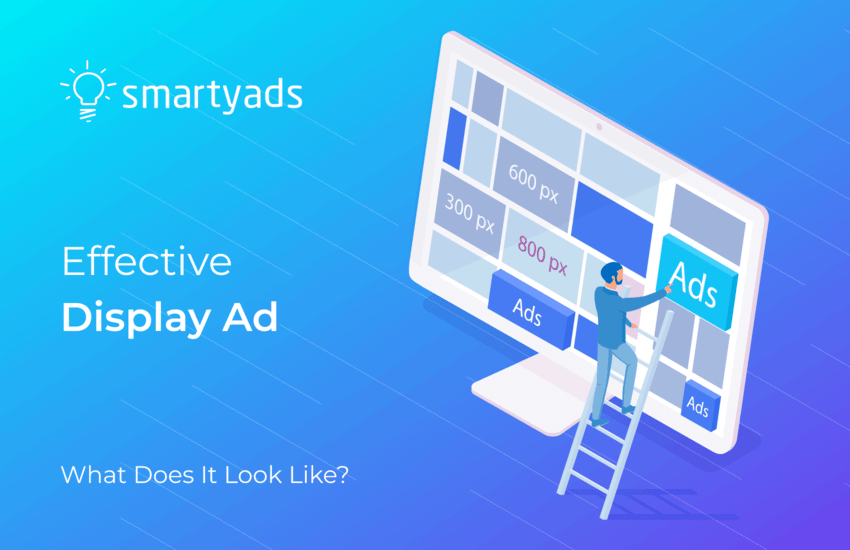
.webp)


